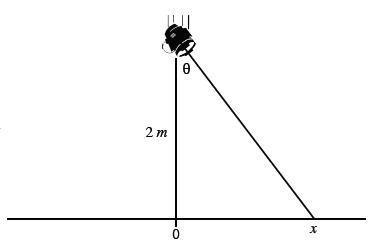Science:Math Exam Resources/Courses/MATH103/April 2013/Question 06 (c)
{{#incat:MER QGQ flag|{{#incat:MER QGH flag|{{#incat:MER QGS flag|}}}}}}
• Q1 (a) • Q1 (b) • Q1 (c) • Q1 (d) • Q1 (e) • Q1 (f) • Q2 (a) • Q2 (b) • Q2 (c) • Q2 (d) • Q3 (a) • Q3 (b) i • Q3 (b) ii • Q4 (a) • Q4 (b) • Q5 (a) • Q5 (b) • Q6 (a) • Q6 (b) • Q6 (c) • Q7 (a) • Q7 (b) • Q7 (c) • Q7 (d) • Q7 (e) • Q8 (a) • Q8 (b) • Q8 (c) • Q9 • Q10 •
Question 06 (c) |
|---|
|
Light Show on the Dance Floor A laser is mounted 2m above the floor (see sketch) and its beam is directed along a straight line on the dance floor. For visual effects, the angle changes periodically and randomly. The angle is chosen uniformly in the interval , that is, the probability density function (pdf) is for and zero elsewhere. The mean x-coordinate of the laser point is given by where a corresponds to the x value for and b corresponds to the x value for . Evaluate this integral (or state that it diverges). NOTE: There was an error in the question as written on the exam and has been fixed on the wiki. |
|
Make sure you understand the problem fully: What is the question asking you to do? Are there specific conditions or constraints that you should take note of? How will you know if your answer is correct from your work only? Can you rephrase the question in your own words in a way that makes sense to you? |
|
If you are stuck, check the hints below. Read the first one and consider it for a while. Does it give you a new idea on how to approach the problem? If so, try it! If after a while you are still stuck, go for the next hint. |
Hint 1 |
|---|
|
There is a clever solution by symmetry that you should exploit if you see it. |
Hint 2 |
|---|
|
(Alternate solution) Otherwise, try a substitution. |
Hint 3 |
|---|
|
A good substitution is by setting . |
|
Checking a solution serves two purposes: helping you if, after having used all the hints, you still are stuck on the problem; or if you have solved the problem and would like to check your work.
|
Solution 1 |
|---|
|
Notice that
is an odd function. The interval in question comes from noting that and so and and so is symmetric about the origin. Therefore,
by symmetry of an odd function. |
Solution 2 |
|---|
|
As in the previous solution, the interval in question comes from noting that and so and . To solve the integral
we use a substitution given by so that , , and so
|
{{#incat:MER CT flag||
}}














![{\displaystyle \displaystyle [a,b]=[-2,2]}](https://wiki.ubc.ca/api/rest_v1/media/math/render/svg/1c5ba85089d180d4bce27d1e29543ca8a67cb3b8)






